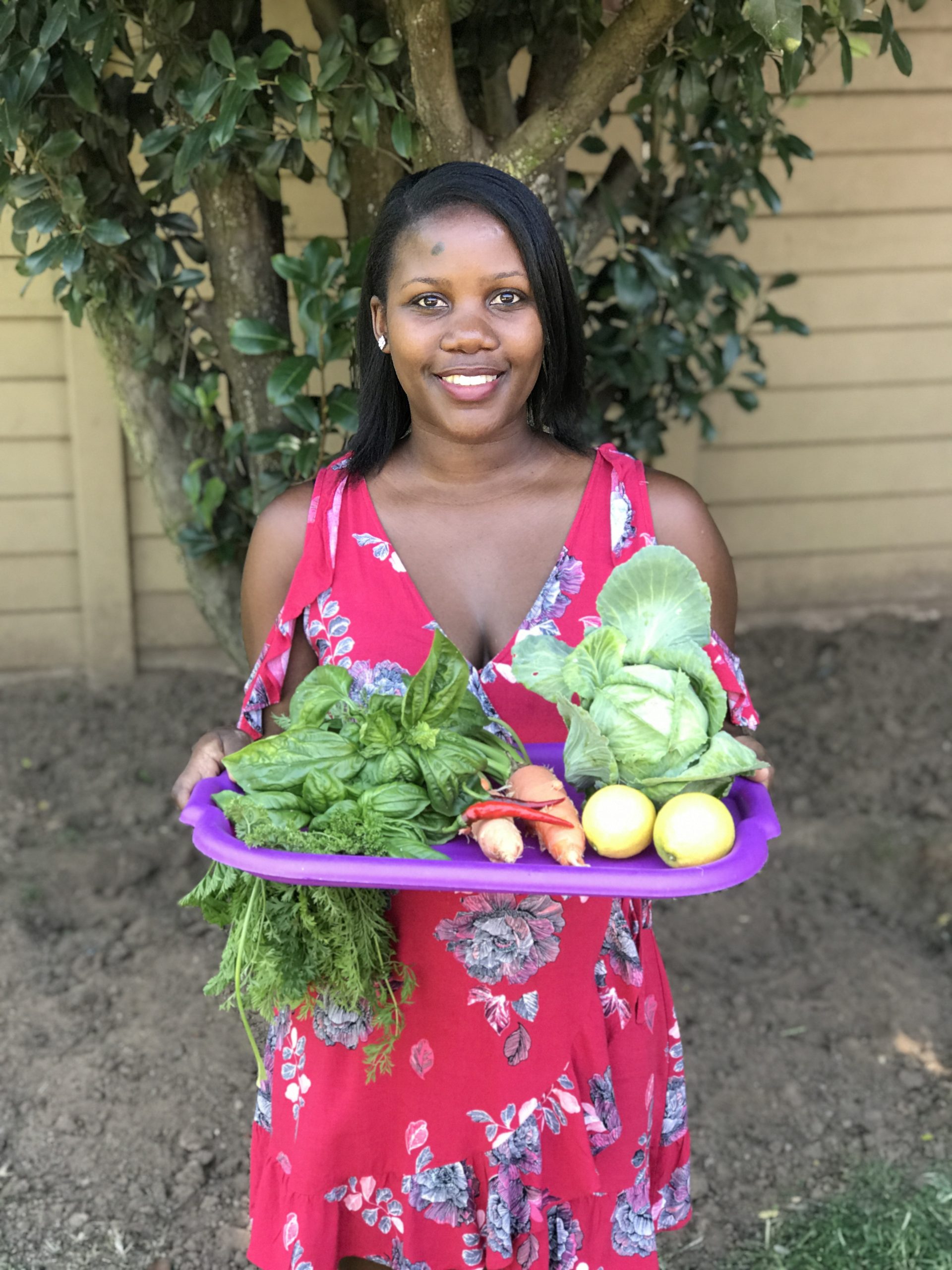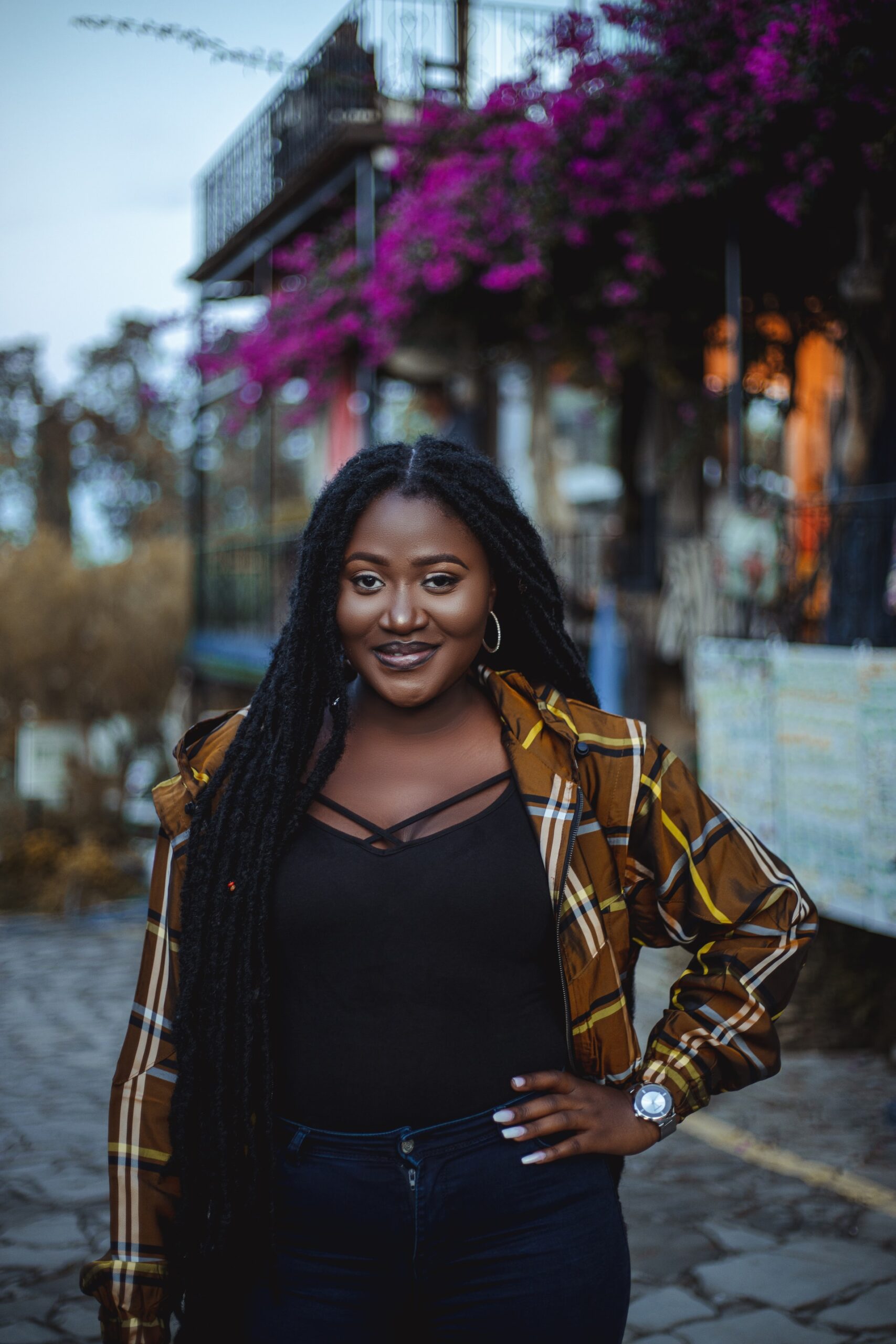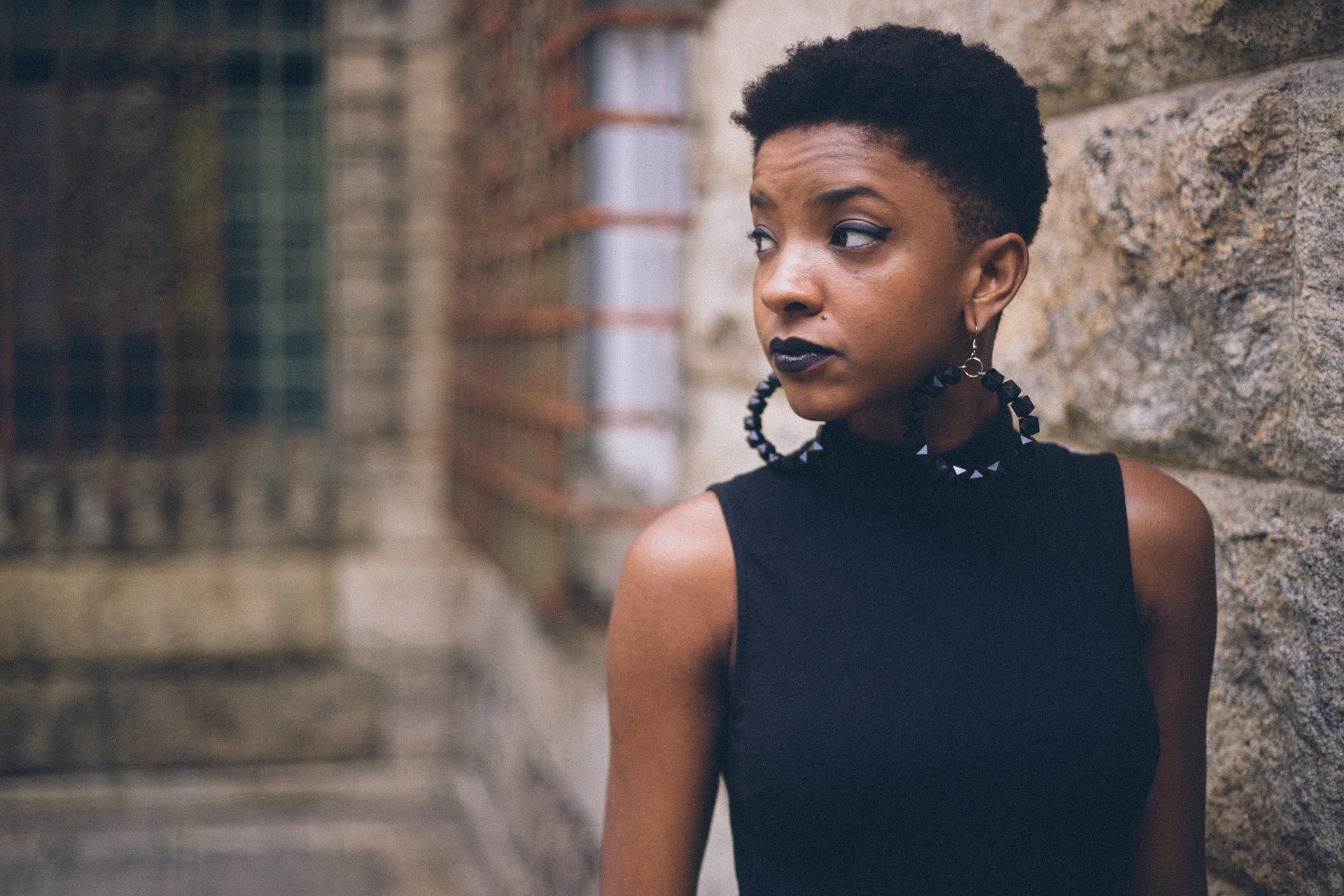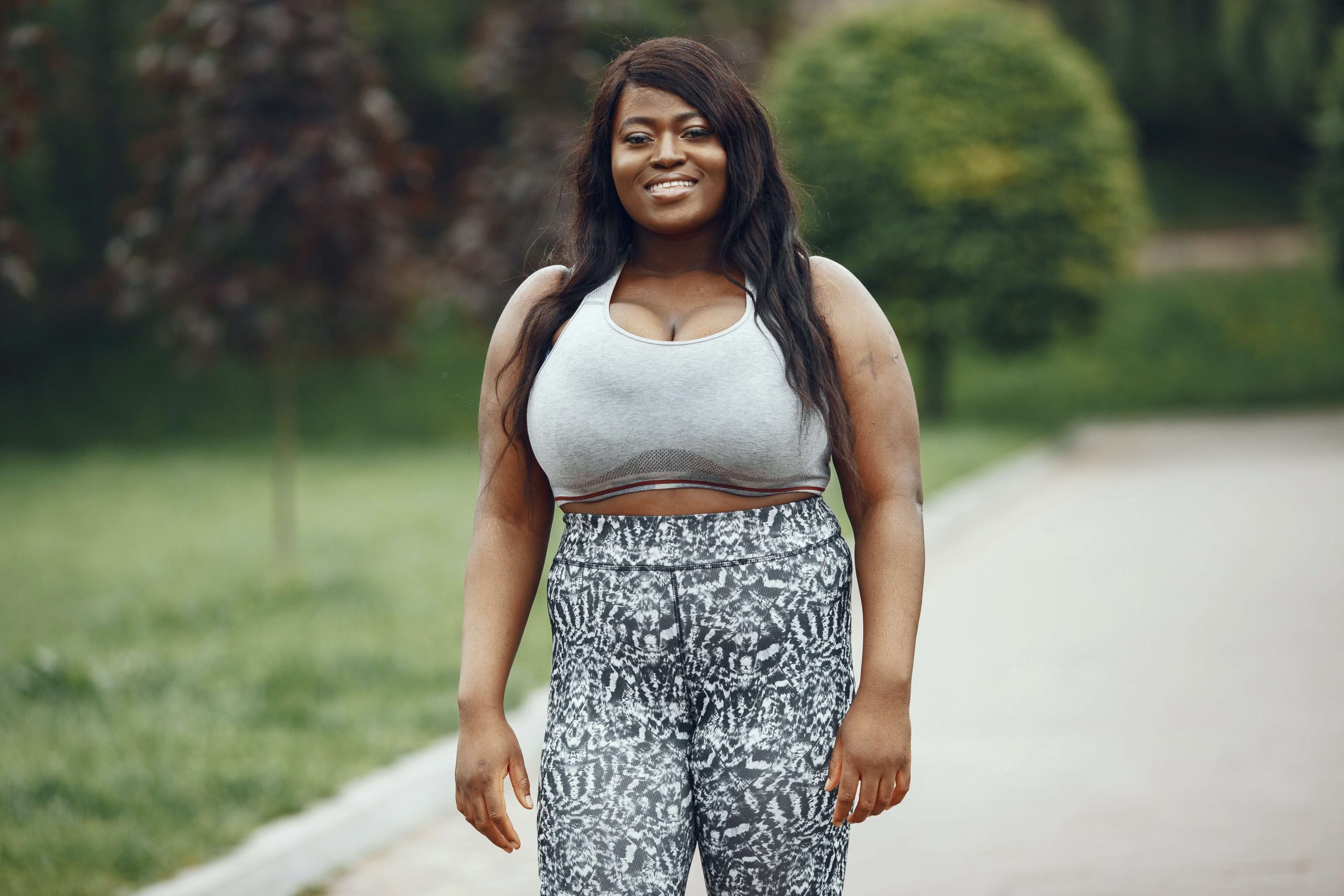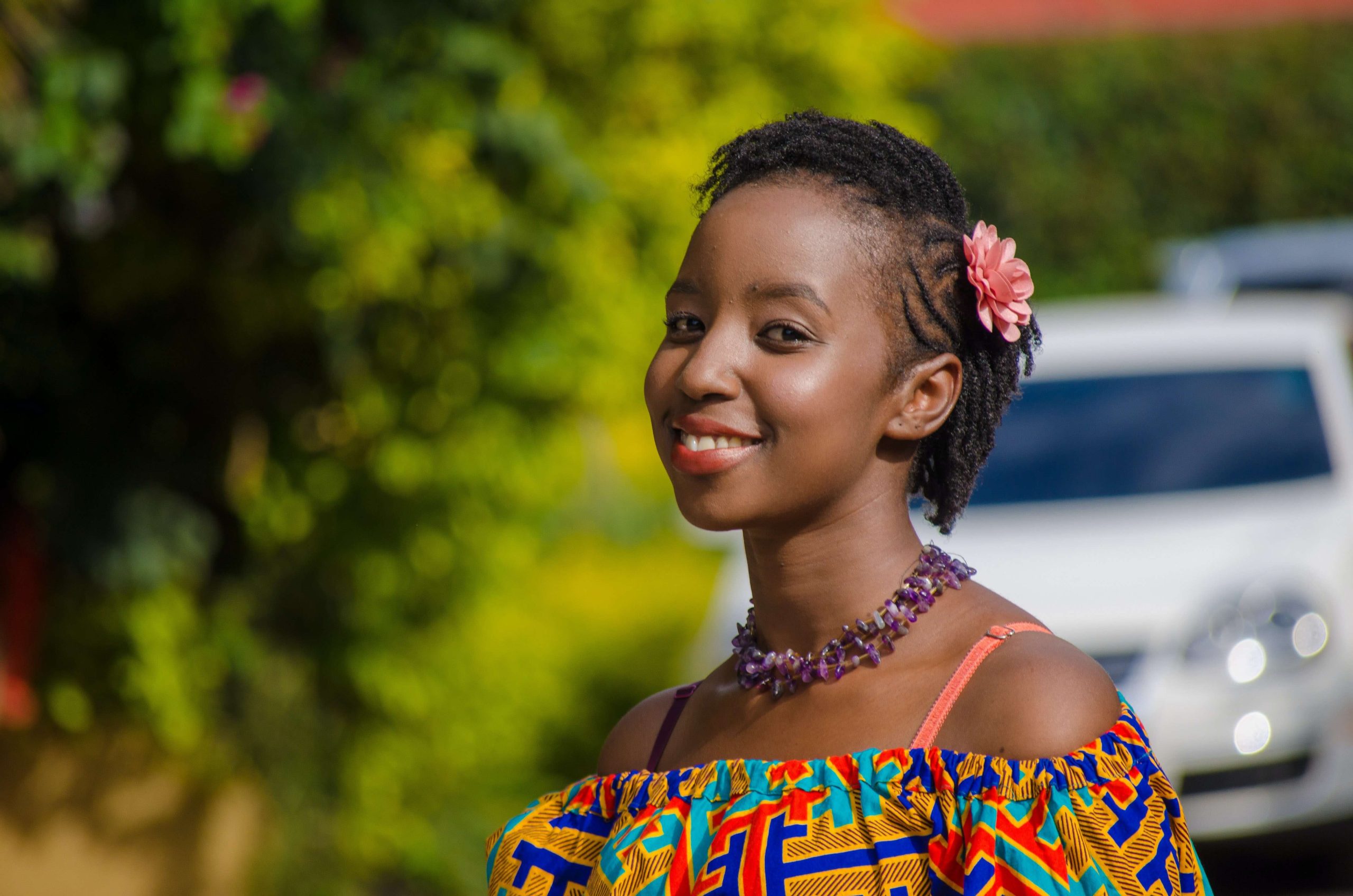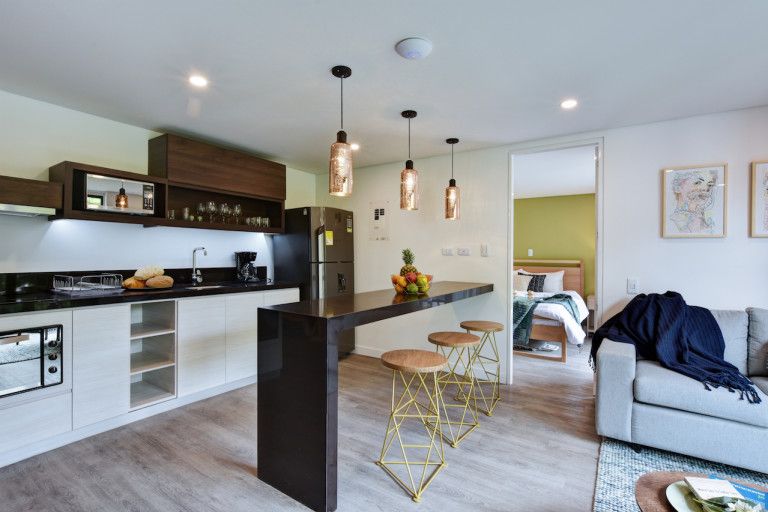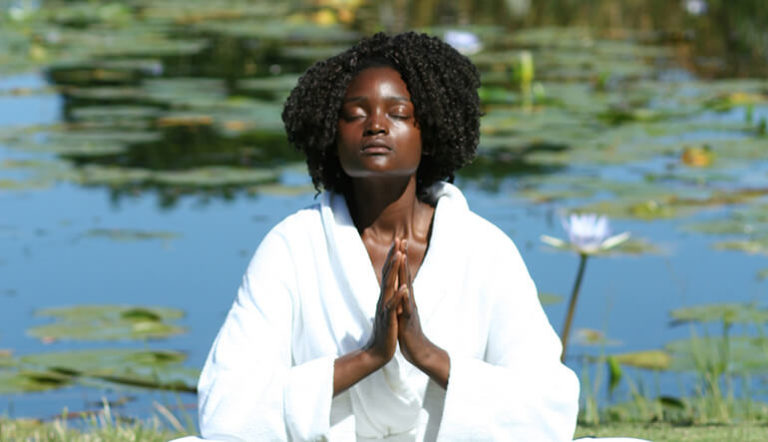A HOUSE IS NOT A HOME WITHOUT A GARDEN
My name is Noma, and I am a self-made home gardener. My goal is to inspire as many people as possible to start their own home gardens so that they can eat and live healthier lives.
When I first started gardening, I never imagined how big of a role it would play in my life. Gardening positively changed my physical, mental, and emotional well-being. Before embarking on my gardening journey, I used to worship junk food! Meals containing greasy, spicy and filling foods were my go-to meals. Soon enough, Irritable bowel syndrome (IBS) caught up with me when the doctor asked – do you eat vegetables?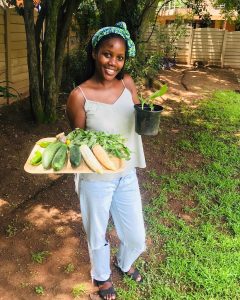
The truth was, I only ate vegetables when I had to. In fact, even if I bought vegetables, they would stay in the fridge until they would go bad, which gave me the perfect excuse to throw them away. At this point, I knew something had to change, and I knew that I had to make that change.
And so, my gardening journey began five years ago when hubby and I moved into our first house and decided that a house is not a home without a garden. This way of thinking was also the best way for me to eat more veggies because once you’ve laboured to grow your own veggies, it just hurts too much to see them go to waste.
The first two years of gardening were a joke because we both grew up with parents who loved gardening. However, we had zero gardening experience and didn’t know where to start. But we had to start somewhere. So, we sliced a store-bought tomato and put it in the ground, along with a few sweet potatoes. The tomatoes sprouted up surprisingly fast, and soon enough, we harvested a handful of happiness. But the sweet potatoes, on the other hand, didn’t give us much when we pulled out the plants. So then, hubby and I decided to put gardening on hold to focus on having our baby boys.
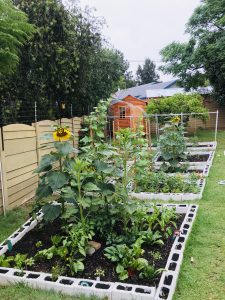 In 2019 I was done with the babies and ready to go back into gardening. But because we neglected our garden for so long, it was covered in grass. We then decided to dig it all out and start the garden all over again. As soon as we started digging, we were greeted with a pleasant surprise of sweet potatoes! Lots and lots of them! For me, this was an undeniable sign that I was meant to use this space for gardening. And that’s how @GardentoPot was born. First on Instagram, and now, we are blowing up on TikTok. As I’m learning to grow, I’m also learning to cook healthier, and that’s the type of content I share on my social media platforms. My boys are also learning to love the garden, from sowing seeds to harvesting and eating carrots.
In 2019 I was done with the babies and ready to go back into gardening. But because we neglected our garden for so long, it was covered in grass. We then decided to dig it all out and start the garden all over again. As soon as we started digging, we were greeted with a pleasant surprise of sweet potatoes! Lots and lots of them! For me, this was an undeniable sign that I was meant to use this space for gardening. And that’s how @GardentoPot was born. First on Instagram, and now, we are blowing up on TikTok. As I’m learning to grow, I’m also learning to cook healthier, and that’s the type of content I share on my social media platforms. My boys are also learning to love the garden, from sowing seeds to harvesting and eating carrots. 
I am truly humbled and honoured by how everyone has received my content. Now I see that there is a real need for people to be able to grow their own nutritious food with no harmful chemicals. Today my garden is my therapy, it teaches me about how life & nature work together. My garden is also my purpose, it helps me inspire others to garden and to take control of their nutrition.
Siphiwe Sithole tells us about the idea that transformed her life
That I would become a farmer was just not on the radar. I did not see this coming. I trained as a journalist at Rhodes university and went on to do a postgraduate diploma in advertising and marketing. After that, I worked in different marketing and public relations positions for corporations and organisations.
In 2015, The Tony Elumelu Foundation accepted me to participate in their Entrepreneurship programme. I had an idea to grow food for African ex-pats living in South Africa. I understood that most people migrating are at the bottom of the pyramid. They are moving from one country to another for economic reasons. When they get into that country, they have to scramble for food. They don't have money to buy groceries for the whole month. They're literally looking for food on a daily basis. They are looking for fruit and vegetables they cannot get.
I come from Mpumalanga, close to the Mozambican border. When I lived in Cape Town I couldn't find things like cassava. Each time I would go to the neighbourhood market, I just could not find the stuff that I could relate to. The demographics of the country have changed. The demographics of certain regions have changed and yet what has not changed is what you are finding on our shelves.
African Marmalade is an African farming business that grows indigenous crops. We started it in late 2015 with the intention of growing food. When I went into business, I thought that, as a top performer in the corporate world, I would be able to hit a profit in six months, but it just took longer. The reality of climate change confronted me; I just did not have the way or reserves to deal with that as a farmer. Being self-funded was pretty tough. I was very cautious. I did not want to make loans to run the business. I had to drastically lower my standard of living. I could no longer maintain the same lifestyle that I had while I was working. 
Sometimes I struggle to even imagine my life before me going into farming. I keep saying, guys, 'What did I use to do? What was I doing on weekends? Because right now I'm happiest when I'm out in the field while before, you know, I would've been, oh, I've gotta go to the mall. I've gotta go to the salon.
Growing indigenous foods, I looked like a lunatic because I was doing something people didn't know. Whatever I planted, people came from the agricultural department, and they wouldn't understand why I didn't have rows and rows of the same vegetable, like spinach, cauliflower or zucchini. I was on less than 2 hectares, and there were more than 30 crops. That, to them, did not make sense. And I told them that you guys don't understand that before I can grow those things on a larger scale, I need to have the seed. And I cannot get the seed. If I need seeds, I would have to travel to different African countries. Or I have to apply for all sorts of import permits. So if I land my hands on a couple of seeds, I have got to grow those seeds for two or three seasons up until I've got enough to grow a hectare.We have our own seed bank that is quite extensive. We produce seeds for ourselves plus for other farmers and households. We are like a network; we keep a record of who we sell to and link people living in the same area as the seeds would have adapted to the environment.
Many people are waking up to indigenous foods, and we've seen many chefs within the culinary spaces that are embracing indigenous ingredients. When people have tasted the foods they've eaten in a lovely restaurant, it encourages them to ask, where do I buy this?
The challenge we have in South Africa, and I don't know how prevalent this is in other African countries: but if people grew up poor eating indigenous foods, they associate them with poverty. So, when you've got a job or a business, you are not going to be eating those foods; you are going to be eating your creamed spinach and brussel sprouts. And not foods that remind you of a time when you didn't have options. When people say,' I have bad memories of these foods, plus I ate too much while I was growing up.' My question is, 'So, do the Chinese ever get tired of eating fried rice and noodles? If they don't, why are you getting tired of eating your own food? The Italians never get tired of eating pasta, but they've been eating it from infancy. You go to India, people are eating Indian food.
We are eating things that don't have nutritional value or very little nutrients, and we are missing out on a lot of the nutrient-dense stuff that is good for us, that our DNA actually can process. A lot of people find that they are gluten intolerant. But they're not even aware, and they're busy eating bread made of wheat. And yet there are things like your cassava flour bread that they could be using and teff flour, that's gonna be gluten-free. There is less resistance and a quicker uptake once people know what some of these food items are good for. And it's part of us depoliticising the food because in South Africa, having lived deep under apartheid with people being segregated and living according to their different ethnic groups, people would say no to foods that other ethnic groups would eat. Once people know the health benefits, people are willing to embrace the foods. 
The introduction of malls in a lot of areas has made people think that their food can only come from a mall. They are being seen as a one-stop shop for everything. The pension sales points, where people receiving government grants would go once a month to receive their pension, were kind of neighbourhood markets. People would set up with an umbrella, which is not happening now with the automation of the system. We don't see those outlets where people can go out and buy. The sad thing is that neighbourhood markets are in the affluent areas not in the townships or settlements. What you are going to find are plaza shops that are not big on fresh food.
I would like to see more neighbourhood markets developing in different areas. I would like to see more people growing their own food. Literally, people being able to feed themselves and sell the excess to their neighbours and for us to broaden the basket of what we are eating.
I think we must eat our medicine. If you do not eat your medicine, if your food is not healing you, if your food is not nourishing, you are gonna spend the rest of your life on supplements. And if you are eating two or three meals a day, and yet you've got this medicine cupboard or your handbag full of medication, then there's something wrong with what you are eating. So change your diet and look at making it more indigenous. All the lifestyle diseases we have result from what we eat. You look at child obesity rates, auto-immune diseases, the increase in autistic cases and ADHD and all the other ailments people have. All of those things, you can actually trace them back to what people are eating. 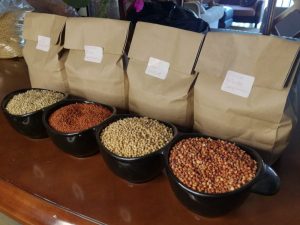
What drives me is getting people to connect and rekindle some of their childhood memories. When they walk through our fields and see what we are growing, it reminds them of their great grandmothers, their grandmothers, and their childhood growing up in whatever part of the country or the continent. When you see that spark, when somebody's face lights up and says,' Oh yeah, I know those beans. I don't even remember the last day I ate them. 'or 'Oh no. My Granny used to..., or when somebody says, you know what, the last time I ate this was when my mom was still alive.’ That just makes me so happy. To be able to say, I am really getting somebody to be in charge of their true self, with their emotions, because we have become a society where we are kind of burying our memories and just being on autopilot.
Personally, I've been able to reconnect. I've been able to get certain smells that remind me of something that happened while I was below the age of 10. It's just been that journey where I remember who I am and what I've missed or what I've lost and what I'm actually now recovering. I wouldn't trade my life for anything right now. I keep on saying, I think I had the perfect midlife crisis. and it sent me into farming.
The African woman whose legacy has changed my life: Wangari Maathai
This is the story of the African woman who made me love the environment. Her story inspired me to pursue a career in environmental and climate justice, and it also inspired me to pursue my dreams, irrespective of the societal limitations placed on my skin colour and gender.
Wangari was born in Kenya on April 1st, 1940, during British colonial rule. Her family was of Kikuyu origin, and her father was polygamous. As a child, Wangari, was given a small plot of land to grow her own food and to learn how to cultivate the land. She completed her primary and secondary education in Kenya. In 1960, she received a scholarship to commence her university studies in the United States of America, where she received a Bachelor's and a Master's degree in Biological Sciences. In April 1966, after returning to Kenya, Wangari met her future husband, Mwangi Mathai, a politician. The two got married in May 1969.
From 1966 to 1982, Wangari Maathai was a lecturer at the University of Nairobi, and in 1971, Wangari received her Doctorate in Veterinary Anatomy from the University of Nairobi, becoming the first woman in eastern Africa to receive a PhD.
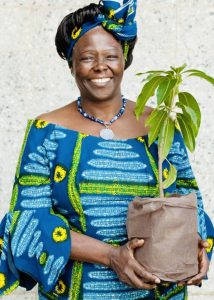 In 1977, Wangari and her husband got divorced. Soon after that, Wangari was imprisoned because she publically contested the judge's ruling regarding her divorce. As this ruling was in favour of her ex-husband and it shamed her for being a woman in need of a divorce. As a result, the judge ordered her to stop using her former husband's last name. In defiance of the judge, she changed the spelling of her last name, adding an "a" and becoming Wangari Maathai. That same year, she founded the Green Belt Movement. This grassroots environmental non-governmental organization planted over 30 million trees across Kenya over the next three decades. This movement became a successful platform for women's empowerment (especially for rural women in Kenya). As a result, she became known as Africa's Mother of Trees.
In 1977, Wangari and her husband got divorced. Soon after that, Wangari was imprisoned because she publically contested the judge's ruling regarding her divorce. As this ruling was in favour of her ex-husband and it shamed her for being a woman in need of a divorce. As a result, the judge ordered her to stop using her former husband's last name. In defiance of the judge, she changed the spelling of her last name, adding an "a" and becoming Wangari Maathai. That same year, she founded the Green Belt Movement. This grassroots environmental non-governmental organization planted over 30 million trees across Kenya over the next three decades. This movement became a successful platform for women's empowerment (especially for rural women in Kenya). As a result, she became known as Africa's Mother of Trees.
Wangari was imprisoned several times in the 1980s for criticizing Kenyan President Daniel Arap Moi and for demanding multi-party elections in Kenya. She stood for environmental justice due to new construction developments that endangered the environment and indigenous peoples' rights. Furthermore, in 1992, Maathai ran for president on a platform urging environmental protections. And at that time, she was the first African politician to embrace that cause publicly. She withdrew from the elections but ran again in 1997. In 2003, she founded the Mazingira Green Party of Kenya and later that year, she was appointed Assistant Minister for Environmental and Natural Resources by Kenyan President Mwai Kibaki. 
In 2004, Maathai won the Nobel Prize for her work in protecting the environment through political lobbying and reforestation initiatives. These initiatives were aimed at empowering rural women in Kenya. This was an outstanding award as it's prestige helped put environmental rights on the map.
In 2006, she was one of the founders of the Nobel Women's Initiative, an organization of six women recipients of the Nobel Prize, representing North and South America, Europe, the Middle East, and Africa, who united in their efforts to work for peace, justice, and equality throughout the world. In January 2007, Maathai hosted the Global Young Greens conference in Nairobi, which some have described as a meeting of the next wave of the leadership of the world environmental movement. In addition, Maathai wrote four books, including "The Greenbelt Movement: Sharing the Approach and the Experience".
At 71, Wangari Maathai died from complications from ovarian cancer treatment at a Nairobi hospital.
But her legacy lives on!
Today millions of women like myself have gained inspiration from her story and aim to share this story with many people. Her passion, resilience and approach to environmental rights and gender equality contributed significantly to my career path. I am forever grateful!
Source for refernace:
The founder of the Green Belt Movement and the 2004 Nobel Peace Prize Laureate
Photo 1 and photo 2 credit: Pinterest
When climate change impacts African women, it also affects me as an African woman
My name is Ms Rosemary Olive Mbone Enie. I am a Cameroonian Geologist, Environmentalist, Social Environmental Entrepreneur (SEE), Eco-communities Builder, Gender and Childhood Ambassador. I was born on the 27th August 1966 in Victoria South West Region of Cameroon.
Victoria, now called Limbe, is a seaside town by the banks of the Atlantic Ocean. While growing up, we had several clean flowing rivers, which took its source of the ranges of the majestic Mount Cameroon through the rocky volcanic terrain into the Atlantic Ocean. Back in the youthful days' rainfall was stable, farmers had specific reasons to plant their crops, and the yields were moderate. The town of Victoria (Limbe) was full of trees and plantations of Oil Palm owned by the Cameroon Development Corporation (CDC) and other local farmers. The city's average temperature was moderate, and Victoria was a liveable city with an average population size.
For the past 50 years, there has been a rapid change in the development of the city of Limbe. The population has grown so fast, hitting over 500,000 inhabitants. They felled many trees to build houses. The city's average temperature has become very hot, especially in the long dry season. Rainfall is very erratic, which sometimes extends to October and November. Many rivers and streams dry out during the rainy season giving rise to water shortages within the communities. Farmers have resorted to using chemical fertilizers to improve their yields, which harms the community's health. Like many African countries, Cameroon faces the challenge of Water Security, food security, loss of biodiversity, etc. My country is already facing consequences of climate change, including an abnormal recurrence of extreme weather phenomena such as violent winds, high temperatures and heavy rainfall, which endanger communities' ecosystems and the services they provide.
For the past 30 years, I have been taking practical actions to address Water, Sanitation, Hygiene, Environmental Education and Management activity across Africa. As a result, I had the opportunity to work with women and youth groups in Cameroon, Nigeria, Ghana, Liberia, Tanzania, Kenya and Rwanda. I kick-started several Pan African initiatives to address environmental and climate change challenges in Africa. I received a scholarship to study Ecovillage Design Education at UNESCO in Germany. It led me to initiate the Pan African Eco-communities Network (PEN) Initiative to transition 55,000 traditional African villages into Ecovillages. In addition, I started the Tunza Afrika Program (TAP) in 2015, which continues to engage, promote and support the interest of young people in water, environment, energy, food, science and technology issues within the formal non-formal educational sectors across Africa.
Climate change poses a unique and general challenge within Africa and at the global level. It concerns everyone on planet Earth. The people likely to suffer most from the impacts of climate change are the Most Vulnerable Groups (MVGs), those least responsible for causing it. It is widely recognized that developing countries are expected to suffer more from the devastating effect of climate change. For example, the African continent is responsible for 3.8 per cent of global CO2 emissions, yet the impact of climate change will be unfairly devastating.
For over 25 years, I have been working in the Gender and Development Sector and 21 years following the International Climate Change Negotiation. Women are particularly affected by the dramatic changes in climate patterns. Women living in poverty are the most threatened by the dangers that stem from global warming. For example, in 1991, when a cyclone and flood severely affected Bangladesh, the death rate was almost five times as high for women as for men. This was also obvious during the Tsunami that hit South-East Asia in 2006, where most victims were women.
Due to the existing gender inequalities, the different roles in society and the division of labour, women and men are not equally exposed to climate change impacts. They do not have the same adaptive capacities. We must acknowledge these differences in vulnerability and adaptive opportunities to ensure the success of adaptation measures. Furthermore, if we consider the gender perspective in communities across Africa, we will avoid further gender inequality.
A gender perspective is often overlooked in debates about climate change across Africa; it is high time to change this with COP 27 in Cairo, Egypt!
Gender analysis is crucial to understand better the impacts of climate change on human communities, particularly food security, access to natural resources, such as water, firewood, and health. Simply because women are often primarily responsible within the family for these tasks. In African countries, the women fetch and carry water at great distances to meet the needs of their village communities. They labour every day, without pay, to grow enough food for their families and communities.
Women can be real agents for change in their homes, their communities, and society as a whole in the continent of Africa. They can take over new renewable forms of household energy, such as biomass, biogas, solar. They can tackle climate change as consumers, as an educator. Their specific role in educating their children can promote behavioural change in human or economic, cultural, social and environmental activities.
When climate change impacts African women, it also affects me as an African woman!
Mpho Mogodiri is Celebrating our Indigenous Heritage
We really need to reconnect with our roots to nature and listen to the elders around the world. I call them living libraries because they actually know most of the things that we don’t know. They have this knowledge, but they don’t know who to share this knowledge with. It’s because we are not asking them about these things. It’s something that I’m trying to spark with my business. To say, ask your grandmother about this, ask your grandfather about this, ask your elder about this and let there be a bit of information sharing. My grandmother would share her stories around fruits. For example, the wild sour plum. Those are the things she would talk about. I feel that knowledge like hers should be preserved somehow. 
People don’t go into the wild as much as they used to. There’s a lot of activities to do now. There’s a TV in every home. There’s PlayStations, there’s Twitter, Facebook and so on. For us, when we wanted to play, we would go foraging and people are no longer interested in foraging. And if people are not interested in something, it loses its value.
I got introduced to foraging by my grandmother. I grew up in the Northwest, in a village called Seolong. We would go foraging with my grandmother and also with friends. It was actually fun to do it. I think it was a great, formative period. It’s a part of who I am. It’s a part of my identity and culture. I believe right now we are losing this knowledge which forms a great part of who we are.
The impact that starting my business had on me is that I really had to connect with my childhood again. Not only that but it’s also taught me that challenges in life are seasonal like the items we would forage. I appreciate nature more. I get to impact other people’s lives because when I go foraging, now, I go with a group of young people. They teach me about these fruits because some of them have been doing this their whole lives. Now they are paid for that knowledge and skill and they get to be paid through me. I get to put food on somebody’s table. It has impacted me that I’m doing good. I’m sharing my gift with other people. I’ve learnt to really listen to the ingredients and just go with the flow. It has shown me a different Mpho. 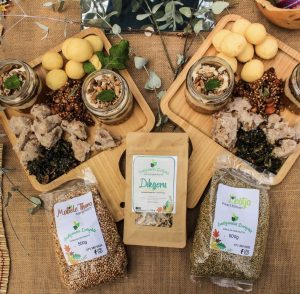
At Indigenous Delights, we produce luxury food, such as jams and chutneys, made out of indigenous, raw products. We exclusively source our raw material from women and youth in the villages in the Limpopo province. We do this to ensure that we provide a way of earning income for women and youth, and also to ensure that the materials we get are indigenous to that area and are collected sustainably.
I wanted to make something that I grew up loving, indigenous delights, into modern food. There’s a certain stigma that comes with some indigenous fruits that I grew up eating. I ate that a lot when I was young because we had nothing else to eat. So, some of the foods are seen as poverty foods. We’re trying to break through that stigma.
Evolving to me means growth. It means pushing boundaries. Knowing that fear is there, but saying to the fear, 'I acknowledge you, fear, but I'm not gonna let you paralyze me'. Evolving means chasing your dreams the only way you know how. Evolving is also growth in terms of knowing yourself and making things happen for yourself and for those that are around you. It’s about opening the door for those who come after you.
How to incorporate more greens into your diet
As most of us strive to live healthier lives, it can become stressful trying to figure out smart ways to incorporate healthier foods into our diets. As someone who is whole heartedly not a fan of salads. I have had to become a little sneaky with how I incorporate vegetables into my diet, especially green vegetables like kale, spinach and zucchini. One thing I have found in my quest is that most of these don't have an overwhelming taste. Which makes it that much easier to incorporate them into our diet. Here are some simple tried and true ways to up your green vegetable intake without turning to salads.
- Smoothies: Now that it is summer in France, a sure fire way to get my greens in is through smoothies. As a workout junkie, I like to get frozen organic spinach from our grocery store and blend this in to my morning banana peanut putter protein smoothie. Not only am I unable to taste the spinach. But I am able to ensure that I got my greens in first thing in the morning which makes eating throughout the day a little less stressful.
- Sauces: One way I like to trick my daughter into eating her greens too, is by adding them into sauces. I like to do this by adding finally chopped greens into tomato sauces (they end up looking like herbs), or grating zucchini into pesto sauce (which is one of the only green sauces she likes and eats).
- Baked goods: In our house baked goods are a staple. Which is why when it is my turn to make them, I like to turn to trust pancakes. My favorite recipe to make is banana oat muffins with half gluten free pancake mix made with almond flour, and regular pancake mix. I blend all this up with my banana's, oats, milk and eggs and of course ly trust greens. Deepening on what I have on hand I like to either use kale or spinach for these.
- Fries: I can honestly say that my life was never the same since I tasted zucchini fries. When made right, these green fried strips of goodness can be delicious and make you forget that they are made of zucchini. There are tons of recipes and interpretations of them online and honestly the taste depends on you and what flavor profiles you like.
- Bread: Like the pancakes, incorporating greens is bed is an easy and sure fire way to get everyone getting their daily greens in. Personally I like to add kale to sourdough bread or good old spinach to banana bread.
What are some ways you incorporate more greens into your diet?
Why changing the world is on all of us
As I write this my recent Vogue UK has just been delivered to my doorstep with power house change maker Malala on the cover. To say that Malala has forever changed the idea that young people cannot change the world is an understatement. In her years since she started advocating for education for young girls. Malala has brought to light the power a single voice, can have on the world. This is also echoed in my home country of South Africa where today marks a monumental occasion for South Africa, youth who marched against the Apartheid government. Resulting in some losing their lives. But in a step in the right direction for change.
Often times when I hear stories like Malala's, or the young people all across the globe changing the world. I am reminded that we need not leave change to the "grown ups". Or even to other people. But rather that in fact if we are sincere in our quest, we too can change the world for the better. This is a great reminder for myself as a young mother concerned with the state of the world.
In looking at what so many are doing, I am reminded that I too can change things in big or small ways. One thing is for sure however is that since becoming a mother I am more committed than ever to changing our world for the better. For one it is brought to my attention (thanks to walks with my daughter in the park), just how little people take care of the environment. As an active toddler who loves the outdoors. When ever we go to the park I find myself picking up litter every five or so steps.
And whilst it started out because I wanted to avoid my daughter nibbling on rubbish she picked up. It now has become a way we can do something together. And instead of telling her no, when she curiously picks up plastic bottles and such. Instead I have taught her to throw them away in the rubbish bins.
It has now become a tradition of ours after playing in the kids section to take a 15 minute walk and pick up trash. Whilst she may be too young to understand exactly what we are doing. I know that instilling in her the idea that having trash on the floor is not good. Is one step in the right direction for our environment. Apart from that we also make a conscious effort in our home to use less plastic. From buying and using reusable straws. To declining plastic cutlery when offered it when we have take out. These small efforts are now part of our families DNA. And hopefully as she sees us doing it, she too can model that behavior to her kids in the future.
How to make your space feel more luxe
You know the feeling you get when you walk into a fancy hotel or shop? Well since we have all been pretty much stuck at home for the past few months. Getting to go to "nice" places has been a thing of the past. Which is why I have been focusing on making my home and space feel a little more luxe. What is luxe you ask? Simply put it is luxurious, fancy and just expensive looking. And whilst I would like to say I have an unlimited budget, I do not. Which means I often have to take a few short cuts when it comes to achieving this look and feel in my home. Here are 6 ways I have found that make my space feel fancy, cozy and hotel like.
- Add flowers: Flowers are the simplest way to elevate any space. And you don't even have to go with the real deal. Pick up some good life like faux flowers and you are good to go.
- Candles: Something about lighting a candle at the start or end of a day can make any space feel that much more special. I love collecting candles and placing them around the house. Lately I have started lighting one in our bedroom, and one in the bathroom. It gives off a soothing effect. And makes the space smell divine.
- White sheets: As one of those people who loves sleep (who doesn't?), nothing feels more luxurious or appropriate than white crisp clean sheets. In our house we even get excited by "clean sheet day". Which is the day we change the sheets on our bedding. White sheets are great as they can be mixed, matched and layered with so many accent colors. They also give a hotel feel. And make a room feel grown up.
- Declutter: With a one year old running around, it feels like I am always picking up her toys or vacuuming our apartment. But if there is one thing I have noticed is that my work is not in vein. Not only does having a tidy and clutter free space visually appealing. It also can help the space feel luxurious. Just think of all the homes you see in magazines and on TV. Most are styled well. But they also don't have a lot of clutter or random stuff lying around. Personally I like tidy our home once every second day for 30 minutes each. This includes dusting, vacuuming and just removing all clutter. On days when I don't do a full tidy, I make sure to open all the windows (even for just 10 minutes to let some fresh air in), and make all the beds in the house.
- Add plants: Nothing is more inviting than having plants in your home. But if you struggle to keep yours alive, fear not.There are many affordable, life like options out there. Even just the illusion of greenery is great for making a space look more considered.
- Hang art: Art is one of the best ways to showcase your personality. With so many prints available, you just cant go wrong. From large scale pieces to smaller ones. One thing I also recently learnt is to vary your art. Check out flea markets and second hand stores for statues, painted art works and photographs to give any room depth and personality.
Bite Size: 4 wellness trends we are obsessing over
When it comes to health, you can say we are a little more than obsessed. From signing our whole team up for the In Goop Health Online summit. To trying and talking about every health trend under the sun. Which is why fresh off of our first few weeks of the In Goop Health summit. Along with some trends we have been seeing online. We have rounded up the top four wellness trends we cannot get over and want to keep doing well into the new season.
- Working outside: Whilst most of us have found a few nooks and crannies to turn into home offices. Very few of us have ventured outside. As in outside our doors. Which is one thing we are looking forward to as the weather is in that perfect in between phase, is working from outside. So grab a chair, your laptop and some SPF and enjoy the rays as you work from the outdoors.
- At home workouts: Gone are the days of crowded gyms and sweaty machines. These days most of us are getting our workout fix from our homes. Whether you use an app or follow your own fitness routine. Getting fit and healthy has never been so much easier (and wallet friendly) as it is now.
- Good sleep habits: As a habitual bad sleeper, I can tell you first hand that not getting enough ZZZs can get exhausting. Which is why I am obsessed with creating a cleaner and better sleeping habits. From keeping electronics out of the bedroom. To ensuring I have a good sleep routine down like drinking tea, reading and ensuring my bedroom is temperature controlled.
- Non alcoholic wine: As somewhat of a wine lover, I can say that this new trend was not one I was into. But once I got a taste of some of the great non alcoholic wines out there I was convinced (sort of). Not only is it a great way to steer clear of midweek hangovers. But it is also a healthier alternative ,
Bite Size: Foods to have on hand so you never run out of things to cook
We’ve all been there. It’s 8pm, you’ve had a long day, you look in your fridge and cupboards or pantry and realize you have nothing to eat; or at least nothing that you can prepare quickly. Which is why stocking your cupboards and fridge with these essentials will ensure you can always throw together a meal in 30 minutes or less, no matter the time or day;
Eggs: There is no end to what you can create with eggs. From east scrambled eggs on toast or a filling omelette. Which is why having eggs on hand is always a must.
Bread: Like eggs, the diversity of bread lies in the different ways you can enjoy it. From toasted sandwiches to simple meal fillers, some good bread can always come in handy day or night.
Canned tomato: As a new mom, I find that most nights it feels impossible to think of things to cook. Which is why canned tomatoes have saved my life time and time again. I like to use the best quality canned tomatoes I can find as these usually mean you don’t have to worry about adding too much seasoning. And I serve them with eggs as a shakshuka for brunch, or tossed into pasta with what ever vegetables I find in the fridge.
Pasta: Like the previous ingredients there is no shortage of what you can do with pasta. Personally I like to cook it in large batches when I have time and munch on it with some vegetables as a pasta salad, or warm with a healthy helping of canned tomatoes or when the mood strikes to make a delicious carbonara with eggs, Parmesan cheese and bacon; yum.
Bacon/chicken breast: Having some kind of protein is always a must. At She Evolves we like to keep chicken breasts and bacon in the freezer at all times for those late night meals. Wether you like yours served with bread, pasta or in a salad, a little protein can go a long way.
Canned fish: This one might seem off but hear me out. Not only is canned fish versatile, it is also a great way to get in those omega 3s and 6s without having to think too much about out. Personally we like having canned tuna for tuna sandwiches or to throw into salads.

